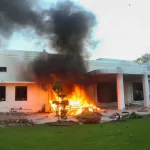A true Perspective – 1971 Dismemberment of Pakistan
By Lubna Ejaz Naqvi
Pakistan had a unique geographical feature. It consisted of two distinct blocks of territory. East Pakistan was not only separated geographically from West Pakistan by one thousand miles, but the departing land was India – a hostile neighbour, who from the day one did not recognise Pakistan’s existence. Hindu leaders gave statements at the time of Pakistan’s creation that it was a temporary division and very soon Pakistan will come into Indian fold again. For them, to execute their nefarious designs, keeping both sides divided and hostile, was the cornerstone of their hostile policy.
Every year, as the 16 December approaches, misperceptions through propaganda stories, about dismemberment of east Pakistan starts appearing in media and social websites. Back ground interviews and interactions with number of veterans who physically participated in the operations in east Pakistan and are witness to entire episode have given different perspective at least on three accounts, number of Bengalis killed and who killed them, number of PoW and what led to dismemberment. A retired colonel, vetran of 1971, who resides now in Rawalpindi, said after elections in 1970, delay in the transfer of power was part of an internal democratic process, and it provided no reason for India to attack and dismember Pakistan. India committed a naked aggression against Pakistan. Indian Parliament approved the support for Bengali insurgents and India was actively involved in training of Mukti Bahni. Indian military, RAW, BSF, all initially took part in training and then actively supported Mukti Bahni actions against Pakistan Army much before start of war on 3 Dec, 1971. Another highly decorated soldiers who earned Sitarae Jurrat for his valour said that India is doing same in Balochistan, Kashmir and even Afghan today. He said, Awami League led by Mujib ur Rehman was part of greater conspiracy. Much before Army’s action on 25 March 1971, Awami League workers had started violent activities. He said, they occupied government buildings, hoisted flag of Bangladesh and targeted pro-Pakistan population. Awami League declared 23 March as Black Day instead of Pakistan Day. Government of Pakistan and Army were left with little options than to tackle these anti state activities with forces.
The period between March 26 and December 16, 1971 was marked by a war is complex in many dimensions – politicaly, militarily, socially, and globally. For Pakistan certainly, it was a civil war waged by a section of society aided by a hostile neighbour. The Bengalis knew it as a liberation war conducted by Mukti Bahini and the Indian military.
For the most part, the war of 1971 has been viewed and analysed subjectively looking only at the subjugation of Bengalis by the state and its forces. This is but one side of the story. Nevertheless there have been other side of the stories.
The first exaggeration is the number of Bengalis killed in the conflict. India puts the number of Bengalis killed in 1971 at three million and some say one million, even though some Indian officials have been using the figures of 300,000 as well. Pakistan puts it as 26,000 based on the daily summaries submitted by units deployed in the field at the time. The famous Hamoodur Rahman Commission Report considers even 26,000 as an exaggerated figure.
Even Sarmila Bose argues in her 2011 book, Dead Reckoning and term the number a a gigantic rumour.
Nobody looks into other side of the story and highlight the number of people from non-Bengali ethnicities – the Biharis and the West Pakistanis – who were killed, maimed, humiliated and looted by Mukti Bahini openly supported by its ‘ally’, India.
There were a large number of West Pakistanis, especially Punjabis, Pathans and Kashmiris, living in East Pakistan.. Between March 1 and March 25, thousands of West Pakistanis and Biharis were killed;
There were thousands of civil servants, businessmen and their employees. When war broke out, it hit the unarmed West Pakistani community, including women and children, the most.
Most people, even in Pakistan, know that the war had perhaps started with the commencement of Operation Searchlight on March 26, 1971. In point of fact, Sheikh Mujibur Rahman and his lieutenants had already made a ‘rational’ choice for armed movement, and the early hours of Friday morning (March 26, 1971) were fixed for the armed uprising. Dhaka University had become one of the training centres for Mukti Bahini.
Bengali sources admitted to have killed 30,000 to 40,000 West Pakistanis during the conflict. International sources gave the estimates between 20,000 and 200,000. The US Consul estimated that up to 66,000 non-Bengalis were killed.
Some 15,000 West Pakistanis had been killed in Bogra alone, with 10,000-12,000 in Chittagong in late March, almost 5,000 in Jessore on March 29 and March 30, 5,000 in Dinajpur between March 28 and April 1, and 5,000 in Mymensingh in April.
According to some accounts, the strength of Pakistani soldiers in East Pakistan was initially about 20,000, which grew to 34,000 by December. So question arises if total number of troops was 34000 then how come the
he much-publicised figure of 93,000 prisoners is true.
Pakistani soldiers, though less in number and facing adverserly much bigger in number fought valiantly.
After the war, Indian Lt. Gen JFR Jacob, in his book Surrender at Dacca: Birth of a Nation, put the figures of Indian military casualties at 1,421 killed, with 4,058 wounded and 56 missing or presumed to be killed. Pakistan’s military casualties during the war were about 4,000. The actual number of soldiers who became prisoners of War does not exceed 26000 by any account.
Disclaimer:
The views and opinions expressed in this article are those of the author and do not necessarily reflect the official policy or position of the Dispatch News Desk. Assumptions made within the analysis may not reflective of the position of Dispatch News Desk.





